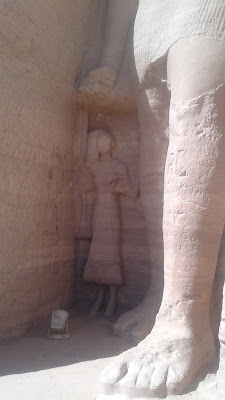HISTORY
The site of Abu Simbel is home to two of the most magnificent temples from Ancient Egypt; the temples of King Ramesses II and his wife, Queen Nefertari. These temples are located south of modern day Aswan not far from Egypt’s border with Sudan. In ancient times, this site was around the 2nd cataract of the Nile River near Nubia.
While scholars agree the temples were built during Ramesses’ reign in the 19th dynasty, there is dispute concerning the construction start date. Some scholars believe work on the temples started around 1264 BC to commemorate the pharaoh’s victory against the Hittites during the famous Battle of Kadesh. Others argue that construction began around 1244 BC which is about the time Ramesses and his sons held military campaigns against Nubia hence the chosen location for the temples.
Today, the temples are located a distance away from their original location. When Egypt started the construction of the Aswan High Dam in the 1960s, which in turn created Lake Nasser, the temples were moved to higher ground. An international crew cut the cliffs and temples into blocks and moved the pieces about 688 ft back and 213 ft above their original position.
The main temple was built to honor the gods Amun, Ra-Harakty, and Ptah and to celebrate Ramesses’ military victory at the Battle of Kadesh. At the back of the temple, in the innermost sanctuary, there is a room with four statues - one each of the aforementioned gods and one of the pharaoh. Twice a year, generally February 22 and October 22, the morning sun lines up perfectly with the center hallway and lights up the statues.
The entrance of the main temple is flanked by four seated figures of Ramesses each measuring 66 ft in height. At the base of each statue are carvings of small figures depicting the pharaoh’s children, his queen Nefertari, and his mother queen Ti.
In the interior of the main temple there are three consecutive halls extending 185 ft into the cliff with these halls flanked by statues of Ramesses.
The second temple is dedicated to Ramesses’ favorite wife, Queen Nefertari, and the goddess Hathor. Its entrance is decorated with several statues of the pharaoh and the queen each having a height of 35 ft.
VISITING ABU SIMBEL
The temples at Abu Simbel are definitely worth the visit; however, getting to the site can be quite the journey. Tourists can either fly to Abu Simbel or make the trek via driving which takes 3 to 4 hours each way. The former is obviously more expensive but the latter can be a test of patiences. I have visited Abu Simbel twice and both trips were via EgyptAir departing from the Aswan International Airport. On my first trip, the optional tour to Abu Simbel was $264 while on this recent visit, it was $293. These tours included transportation to and from the Aswan International Airport, the flight, transportation to and from the site, and admission to the temples. The flight generally lasts around 45 minutes and tour groups are given approximately two hours to explore both temples.
The downturn in tourism has greatly impacted the trips to Abu Simbel mainly in that there are only a handful of flights to the site. Before the Egyptian revolution of 2011, there were plenty of flights to the temples each day but now, from Aswan International Airport, there are only a few flights offered twice a week. The alternative to flying is driving to Abu Simbel with drives originating from Aswan and the round trip lasting several hours.
When I went to Egypt in 2010, the flight departed on time and we had a full two hours on site which was great because Abu Simbel was packed with tourists and vendors. Unfortunately, things did not go according to plan on this recent trip since our flight was delayed by almost an hour. This delay cut our time at the site in half giving my tourmates and I just one hour to explore the two temples, which fortunately was sufficient since Abu Simbel was practically void of tourists. I honestly think there were less than 100 people at the site the morning my tour group visited the temples.
While the majority of trips last just a few hours, there are several lodging options available at Abu Simbel for those who are interested in spending more time at the site. Overnight stays are especially popular on the two days of the year that the morning sun lines up with the central axis of the main temple lighting up the statues in the inner sanctuary.
NOTE If flying to Abu Simbel, request a window seat on the left side of the plane. This provides the opportunity to catch a glimpse of the temples from the sky.
NOTE If you have mobility issues, I highly recommend you request a golf cart ride to the temples. It is a considerably long, steep walk to the temples from the parking lot and vice versa.
NOTE When traveling with a tour group, tell the guide that you are interested in the Abu Simbel postcard set. You are not allowed to take pictures inside the temples but there are some really good quality postcards available from certain vendors.









The raising of these temples occupied peoples' imaginations and many news articles focus in the 1960s. After seeing many photographic layouts of the deconstruction and reconstruction of the two temples in National Geographic and other magazines, this was the most familiar Egyptian temple before I visited Egypt. The site was both what I expected and yet different. I wish I had had more time inside. Since I accompanied a person with mobility issues, the shortened trip had a greater impact on what I got to see inside the temples. If you had no choice but to travel by bus to see Abu Simbel, it would still be worth the trip.
ReplyDelete